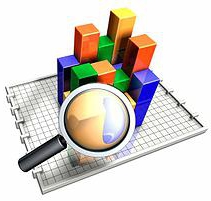The work of a commercial enterprise requires not only the introduction of modern technologies and increased labor productivity, but also serious analytical work in the field of studying the financial and economic results of company activities. By what methods is this line of business implemented in modern companies?
Definition of financial activity of the enterprise
What is a "financial activity"? This is a complex term. Most often it is understood as activity associated with extracting commercial profit, increasing the efficiency of production processes, and reporting procedures.

In some cases, an analysis of the financial activities of the enterprise is carried out in order to identify the economic performance of the company as a whole, as well as to study the quality of work of various corporate institutions: management, accounting sales department etc. From the point of view of economic science, such procedures belong to the category of microeconomic ones, that is, they reflect the state of affairs at a local object, and may in no way correlate with macro-indicators.
Why conduct an analysis of financial activities?
Analysis of the financial activities of the enterprise is the most important tool to increase the competitiveness of the business. Based on various indicators, key management decisions can be made. Through the procedures in question, the effectiveness of already implemented management concepts can be investigated, as well as their necessary adjustment after receiving the results.
The results of the analysis in question can be used by management when a plan of financial and economic activity of the company is drawn up. So, having received these or those numbers, the company's management can set a strategic goal - to achieve such and such indicators to increase the efficiency of the business model. The financial plan of an enterprise may also include investment aspects that include emphasis in the direction of cash flows. A detailed analysis of the respective activities of the company will also help determine priorities.

The results of studies on the effectiveness of an enterprise’s business model can help its owners build positive relationships with investors, lenders, partners, and in some cases with customers. The results of the analysis are an important factor determining how, as we noted above, the plan of the financial and economic activities of the company can be. The significance of the corresponding type of analysis is the highest, especially in highly competitive business sectors. Managers of many of the largest firms conduct such studies on a regular basis.
Methods of analysis of financial activities
What methods can be used in the analysis of the financial activities of the company? An appropriate type of study involves studying the profile of the company in several aspects, and in each direction of work, individual approaches can be used.
For example, a method is widespread, the basis of which is the study of business plans of enterprises for validity and balance. Also, an approach is often used in which analysts study specific indicators of business performance in certain areas.A fairly common method is that in which the financial results of an enterprise are compared with competitive firms commensurate in terms of revenue and market size.

In most cases, approaches to business research suggest a systematic approach. This is due to the need to create a comprehensive description of the enterprise: in some aspects, it will probably be inferior to competitive businesses, but in others it will far surpass them. A systematic approach to the analysis of the company’s activities will help to identify the primary performance indicators of the company, on the basis of which a general assessment of business performance will then be developed.
Data Sources for Analysis
The financial activities of an enterprise are expressed in local operations, most of which are documented. Relevant sources are then used in the analysis of the activities of the company. What documents are we talking about? What sources are used to account for financial activities of a company? There are a lot of them.
First of all, these are documents related to financial statements. Among these are sources capturing profits and losses, various annexes to them. These are documents that reflect information on changes in capital, on the movements of financial assets.

The main aspect of financial statements is balance. The documents in which it is recorded allow a sufficiently reliable assessment of how successful the current financial activities of the enterprise are.
The balance sheet allows you to evaluate such indicators of commercial activities of the company as asset and liability, working capital, net assets, stability, solvency, liquidity ratios (a little later we will examine their essence in more detail).
Another important source that allows you to determine how effective financial activities are is the profit and loss statement. This document records, respectively, the revenue and expenses of the company in relation to certain areas of activity.
Statement of Changes in Equity - Another major document through which the financial activities of the company can be analyzed. This source has a fairly complex structure. So, in that there are four sections. The first three record indicators related to the capital of the company in relation to the reporting year. This area of the report contains information on adjusting the amount of capital and its components, profit, reserves. The fourth section of the document records factors that directly affected the change in capital. This may be the issue of additional shares or adjustment of their value, the appearance of other income or expenses of the company.
Another significant source without which it is problematic to carry out a full analysis of the financial and economic activities of the enterprise is a cash flow statement. This document includes information regarding incoming and outgoing financial flows in relation to the current activities of the company in the direction of investment and other strategically significant activities.
The balance sheet is also accompanied by a special application. It may contain facts useful from the point of view of adjusting financial activities that can be obtained in the course of analysis. Thus, the application to the balance sheet can also be considered a significant source in assessing business performance.
Enterprise Performance Criteria
We studied the main sources by which the financial results of the enterprise can be investigated. Now consider the key criteria by which to evaluate how effective a business is. In general, they come down to determining whether the results of an enterprise’s activity are relatively high in relation to costs.A company, relatively speaking, will be evaluated as effective if it can produce a lot with small investments. Also, certain indicators, as we noted above, can be compared with the achievements of competing companies.

The main criteria that help determine whether a business is effective can be presented in the form of the following list.
Firstly, it is the efficiency of the use of resources that are involved in production processes. It can be fixed assets, personnel, finance, raw materials. Secondly, it’s quality investment policy companies (how quickly the investment pays off). Thirdly, it is the effectiveness of engaging the assets of the company - for example, in terms of turnover. Fourth, this is the quality of capital use, which can be estimated based on the amount of profit per share of the company. Let us now consider individual indicators, based on which in the course of the analysis it is possible to evaluate the financial result of the company.
Among the most important are liquidity ratios. We study their specifics.
Liquidity ratios
These indicators of the financial activities of the company characterize the extent to which it is able to satisfy the requests of holders of short-term bonds issued by the company. Among the factors in question are those that are related to absolute, urgent and current liquidity. For each of them, a separate calculation formula is used.
The coefficient correlated with absolute liquidity is an indicator that allows you to determine the proportion of short-term bonds that can be covered by the funds of the enterprise, as well as shares and deposits. The main criterion is that they must have absolute liquidity.

The ratio, correlated with average liquidity, shows the proportion between cash (as well as assets such as receivables and short-term investments) and debt obligations. If the analysis of the financial and economic activity of the enterprise fixes the indicator in question in the amount of more than 1, then this can be considered an excellent result, 0.7-0.8 - acceptable.
The coefficient correlated with current liquidity is calculated by dividing current assets into short-term bonds. It is an indicator of whether the company has enough funds to pay off the corresponding obligations. An interesting fact: if there are much more current assets than bonds, then the financial and economic activities of the enterprise can be assessed as insufficiently effective due to the irrational distribution of assets.
Net working capital
Another important indicator of a firm’s performance is net working capital. It is usually calculated in the national currency of the country in which the enterprise operates. It is calculated as the difference between the assets of the company and short-term debt obligations. If there is insufficient capital, this means that the company will not be able to repay loans and bonds in a timely manner. But if the corresponding indicator exceeds the value reflecting the amount of liabilities, then, as in the case with the current liquidity ratio, this may indicate that the resources of the company may be used irrationally. In practice, this may be an excessively voluminous issue of shares or too high lending activity.
Stability factors
The analysis, which assesses the financial and economic activities of the enterprise, may involve the study of indicators that are consistent with the structure of money capital, which can give a fairly clear idea of the stability of the company. Such criteria are indicators of how the company's own funds and borrowed finances are related, and also show how much the business is dependent on external lenders.
Among the indicators in question is a coefficient correlated with financial independence. The lower it is, the more debt the company has, and the higher the likelihood that it will not cope with its obligations. However, too low a coefficient value may indicate that the company is experiencing a shortage of financial resources.
Another indicator within this category is the ratio of total liabilities to the assets of the company. It is an indicator of the size of the assets of the company, financed by attracting loans. The optimal value of this parameter is 0.2-0.5.
Also important are indicators reflecting how the assets of the company and its long-term liabilities are related, what is the proportion of the company's debt and equity, as well as “long-term loans” and non-current assets. If the researcher who analyzes the financial and economic activities of the enterprise examines these parameters, then he will have more information at his disposal that reflects how dependent the company is on debt obligations.
Profitability ratios
Another group of factors important from the point of view of business valuation correlates with the profitability of the company. What indicators within this category can be considered the most important?
First of all, this is a coefficient that is correlated with the level of profitability of sales. It shows what is the amount of net profit in the total sales of the company. Another important factor is one that correlates with the return on equity of the organization. This parameter shows how much investors earn per unit of invested currency. An important indicator is the coefficient correlated with current assets. It shows what the company’s capabilities are in terms of generating revenue relative to the working capital involved. The higher the ratio, the more effective the business. Analysis of the financial and economic activities of the company may involve the use of another important parameter - a coefficient that is correlated with non-current assets. It shows whether the firm is getting enough profit relative to fixed assets. The higher this parameter, the more effective the business. Another important factor in this category is related to return on investment. It shows how many units of currency a firm invested in production in order to receive one unit of profit.
Business ratios
Analysis of the financial activities of the company may also involve identifying ratios that are consistent with the business activity of the company. There are several such indicators, and all of them allow us to understand the extent to which the company effectively uses its money. Consider the essence of the main indicators.

Among the most significant, this is a coefficient correlated with the turnover of working capital. It shows the extent to which investing in working capital is effectively carried out, as well as how this affects the dynamics of sales. The higher the coefficient, the more effective the business model of the enterprise is considered.
Another important parameter is associated with the turnover of fixed assets. This indicator characterizes the extent to which the company effectively uses fixed assets. The higher the ratio under consideration, the better the business model of the company.
Another significant parameter that allows us to understand how successfully the company conducts its financial activities is a ratio that is correlated with asset turnover. It shows how efficiently the company uses all its resources.
The coefficient reflecting inventory turnover is also considered as a significant indicator of the success of the financial activity of the enterprise. It shows how fast the company sells stocks.The higher the ratio, the smaller the amount of cash the company is placed in these types of assets, which are characterized by low liquidity.
Another significant parameter is the ratio correlated with accounts receivable. It shows the length of the period in which the company collects funds that external entities owe to it. If this indicator is too high, then this indicates the difficulties that the company experiences when working with counterparties or borrowers.








